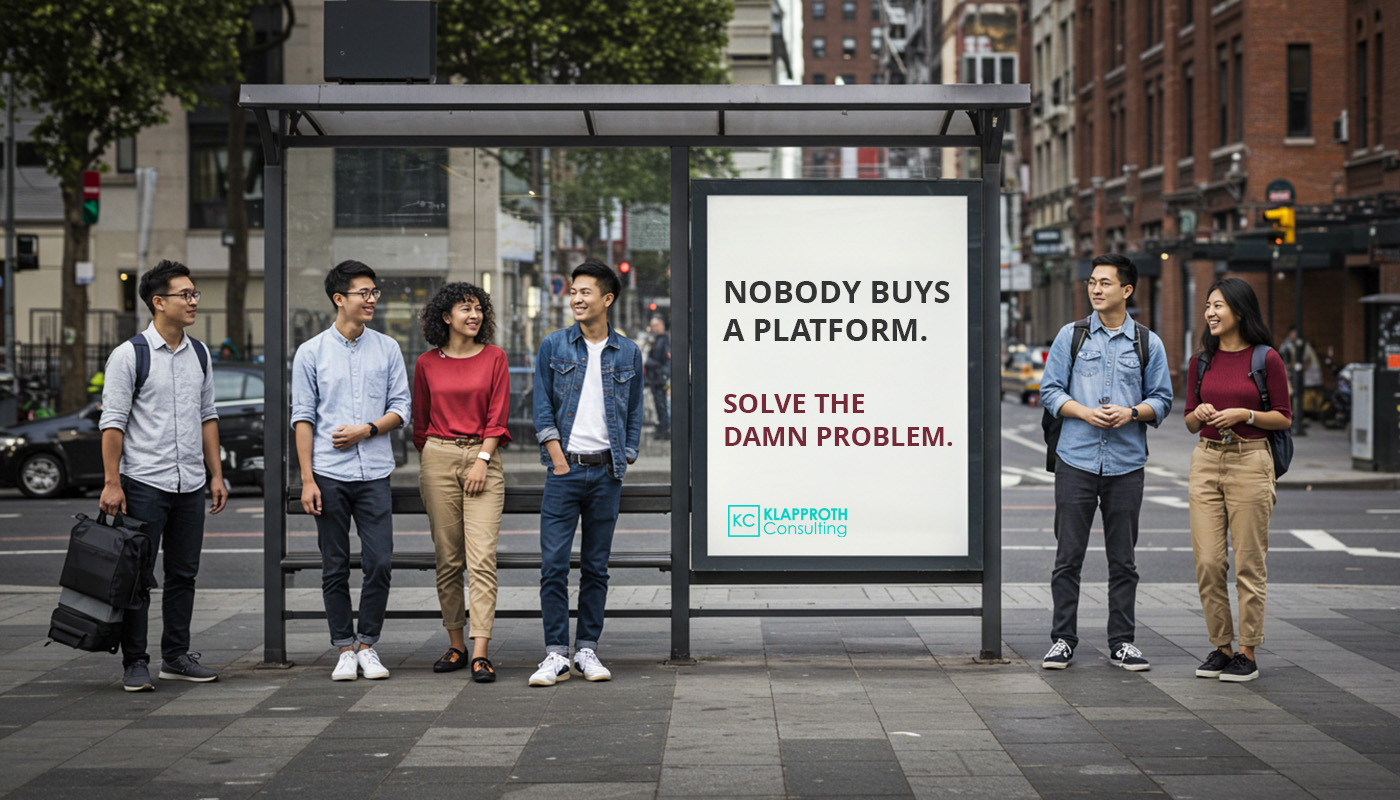First things first: stop calling it a platform. No one cares.
Look, I get it. You didn’t spend three years in a lab, on a whiteboard, or buried in code just to slap a few features into a single-purpose tool. You built a platform. Something elegant. Modular. Future-proof. Your baby can do anything.
But here’s the reality: Your buyers don’t want a platform. They want a solution to a $10 million problem. Right now. Today.
Not next quarter.
Not after you onboard them onto your “open ecosystem.”
Not with a slide deck showing phase 2 and phase 3.
Just a hard, fast fix for a painful, measurable business issue.
Platforms are What Founders Sell. Outcomes are What Buyers Buy.
“Platform” is founder-speak for flexible. But to a buyer, it screams:
- It’s not ready yet.
- You want me to figure out how to use it.
- You’re asking me to take a bet on your vision.
Bad bet. They’ve made those before. And they still have the scars.
Instead, speak to what your product does. Nail the one urgent, expensive, unavoidable problem your buyer loses sleep over — and solve that. That’s your wedge. That’s your hook.
Want to earn permission to expand later into “platform” territory? Great. But first, prove your tech can deliver meaningful ROI — in real dollars, time saved, or catastrophic risk avoided.
Your Vision Isn’t the Value. The Use Case Is.
Here’s the punchline: You’re not selling what it could do. You’re selling what it already does better than anything else. And if you’re thinking, “But our platform is unique because…” — stop. That’s not what your buyer is asking.
They’re asking:
- “Can I implement this without a PhD?”
- “Will this move the needle in a KPI my boss cares about?”
- “If I blow my budget on this, will it make me look smart or get me fired?”
Your job is to make that answer obvious. Fast.
If your product can do everything, but solves nothing, congratulations – you’ve built a science fair project, not a business.
What to Do Instead
If your homepage says “platform,” kill it. Replace it with one urgent, visceral benefit. Something like:
- “Reduce equipment downtime by 60%.”
- “Detect faults before the grid fails.”
- “Cut simulation time in half.”
Then, back it up with one clear use case. Not a roadmap. Not a flowchart. Show me how it works in a world I already live in. That’s how you go from “nice to have” to “we need this yesterday.”
The Bottom Line
The companies that win aren’t building the most versatile tech. They’re the ones solving the most expensive, specific, painful problems better than anyone else.
So stop calling it a platform. Start proving it’s a profit machine.
And if you’re not sure how to make that leap — let’s talk. Because if your product’s as good as you say, you deserve more than polite demos and tire-kickers.
No One Buys a Platform. They Buy a Way Out of a $10M Nightmare.
At the end of the day, nobody’s swiping a corporate credit card for your abstract architecture diagram or your grand vision of a “modular, scalable ecosystem.” They’re buying a fix. A win. A measurable escape from a painful, costly problem that’s staring them down right now. So if you’re still leading with “platform,” you’re marketing a philosophy, not a product—and your prospects don’t have time for sermons. They want ROI, not R&D. Strip the fluff, kill the jargon, and aim straight at the problem that makes them bleed. That’s how you stop being an interesting idea and start becoming the obvious answer.
Ready to stop preaching “platform” and start engineering explosive, marketing-led growth? If your tech’s legit but your messaging smells like vaporware, it’s time to fix that. No fluff, no fluffers – just real talk and real traction. Reach out today with absolutely no strings attached and let’s turn your brilliant build into a buyer magnet.

